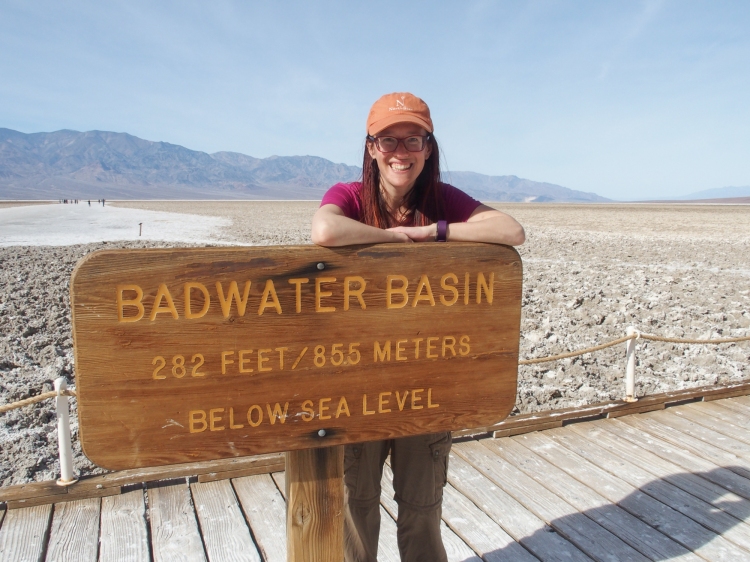When you think of Death Valley National Park, you are probably envisioning Badwater Basin. It’s extremely dry and one of the hottest places in the world.
So that’s why we decided to visit in January! We experienced highs in the 70s, well below the 110+ degree heat you can expect in the summer months. The record temperature in Death Valley is a blistering 134 degrees!
We attended an excellent ranger talk at Badwater. Check out this program or any ranger talk at your next national park. They are consistently fun, informative, and great for all ages.



There is so much more to the park than Badwater though.
Dantes View provides a great visual overview of Death Valley. It’s from this vantage point that you get to appreciate the magnitude of the park. The mountain ranges on either side of the valley were larger and more dramatic than we expected. (There is a road from the valley floor, so you don’t have to hike up 5500 feet to see this vista.)

Mesquite Flat Sand Dunes are the largest dunes in Death Valley. Dunes only form in a couple areas of the park where the mountains slow the wind, stopping the sand from blowing farther. Most of the park has loose gravelly sandy soil instead of the beach-like sand found here. There are no trails as the sand is constantly moving and shifting. We very much enjoyed wandering the dunes.


Artist’s Palette on the Artist’s Drive came highly recommended to us by an 8 year old at the Death Valley visitor center. He told us Artist’s Palette was his favorite place because it looked like scoops of ice cream. He wasn’t wrong.

Zabriskie Point is a popular spot, and for good reason. A very short paved path leads up to the viewpoint, which offers stunning views of the surrounding badlands carved by erosion.
It’s hard to imagine creatures living in such a dry barren landscape, yet they do. On our way back, with the sun well below the horizon, we were treated to a dozen or so bats swooping and feeding on insects.


Devils Golf Course looks like an alien world. A labyrinth of salt mounds extends far into the distance. We tried to spend 30 minutes to an hour at each viewpoint in the park to fully appreciate it. Sometimes, as in this case, we got the area completely to ourselves. Our period of quiet solitude in this bizarre landscape was quite memorable.

We spent our nights at the Furnace Creek campground. It is centrally located for visiting all the places we’ve mentioned in this post. The campsites are close together, but a few of them, like our walk-in site #126, feature great shade. And most importantly in the desert, the campground has potable water!


In our next post, we’ll share photos and stories from some day hikes and less visited parts of Death Valley National Park.

Wonderful views. Helped me to take a breath. Thank you.
LikeLike
You’re welcome Mary! Glad to add a little space and relaxation to your day.
LikeLike
As always, stunning photography and descriptions. I enjoy following your hikes. My best to you both.
LikeLike
Thanks Chris! Hope you are well 😀. By the way, we were able to hang out with Alex yesterday. Always nice when our paths overlap.
LikeLike
Love your blog and photos!
Happy to see you out and about again.
Enjoying time with your dad and Susan here in Cincinnati.
LikeLike
Thanks Gail! We just spent some time with Dad and Susan last week, which was really fun.
LikeLike
What a fascinating landscape to explore. Those dunes are beautiful. And those salt mounds… they through off all sense of proportion, making a human look like a gnat in a barnyard (the mounds look like cow patties that have been trumped all over by a herd of cattle!). How neat to have it to yourselves.
LikeLike
It really feels like another planet!
LikeLike
Really interesting. Thanks for sending. Jan
LikeLike
Thank you Jan!
LikeLike
Beautiful!
LikeLike
Thanks Jane, our National Parks sure are special places!
LikeLike